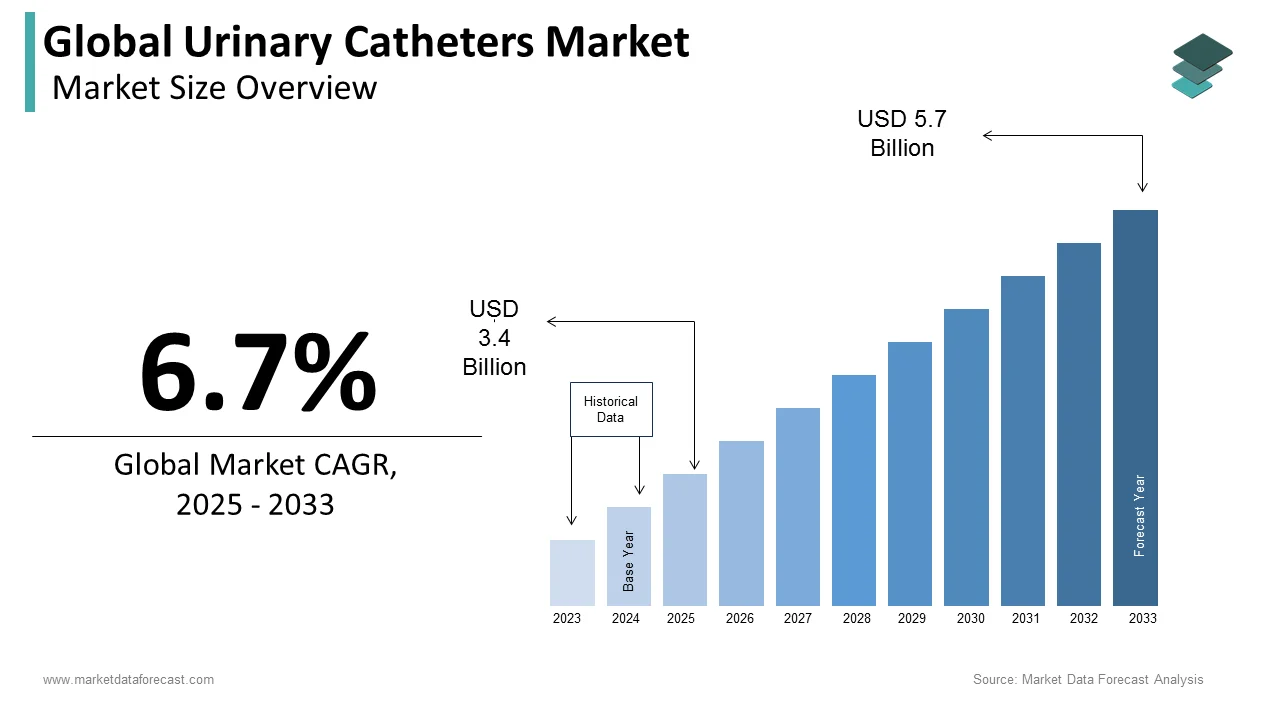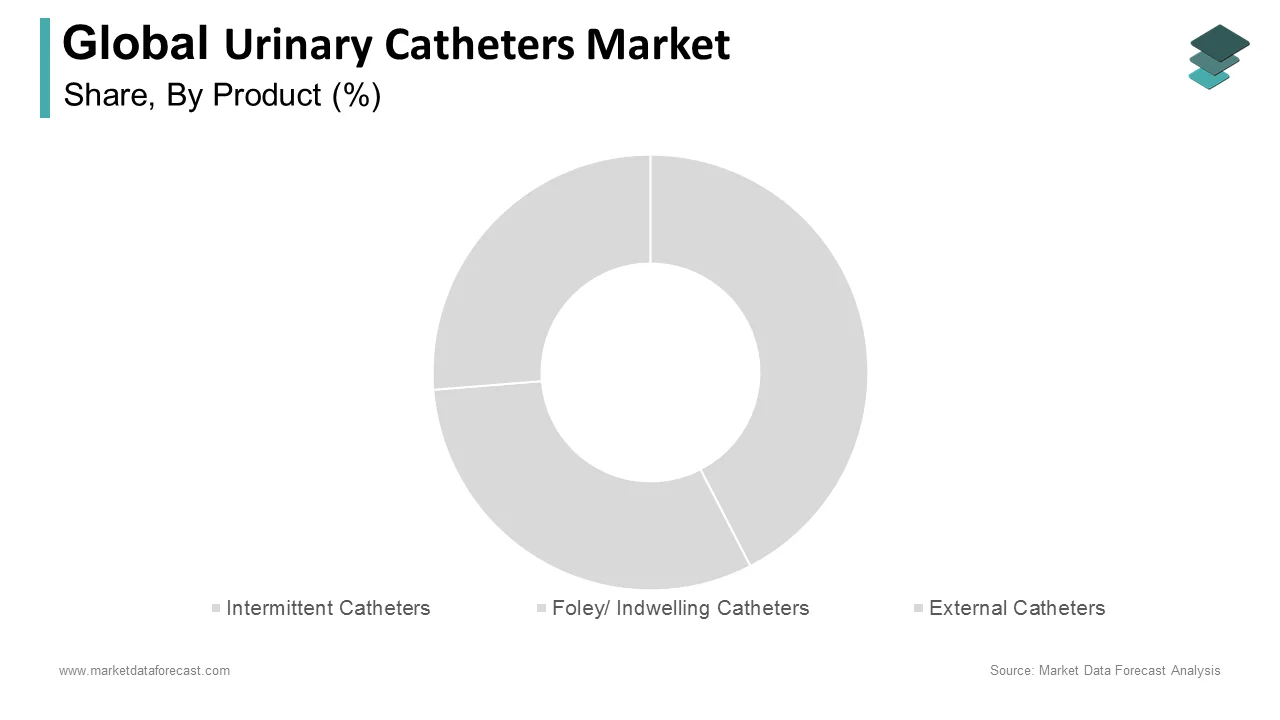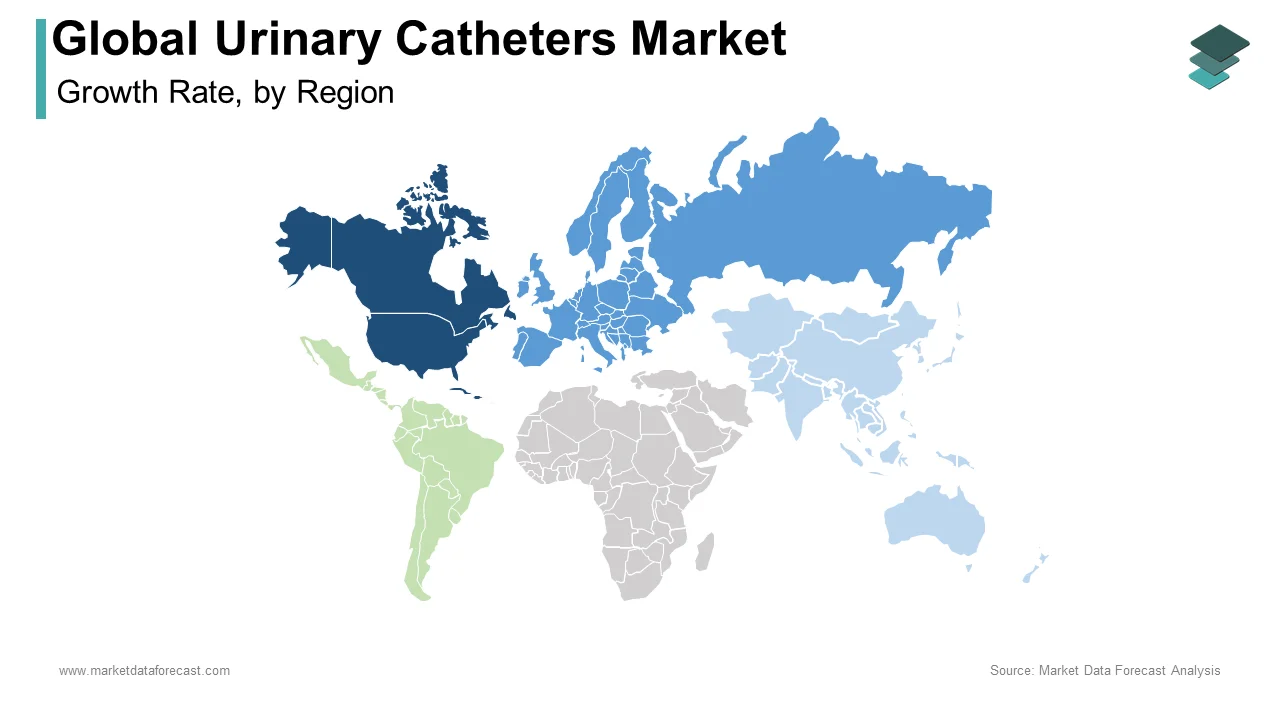Global Urinary Catheters Market Size, Share, Trends & Growth Forecast By Product (Intermittent Catheters, Foley/ Indwelling Catheters and External Catheters), Application and Region (North America, Europe, Asia-Pacific, Latin America, Middle East and Africa), Industry Analysis From 2025 To 2033.
Global Urinary Catheters Market Size
The global urinary catheters market was worth US$ 3.2 billion in 2024 and is anticipated to reach a valuation of US$ 5.7 billion by 2033 from US$ 3.4 billion in 2025, and it is predicted to register a CAGR of 6.7% during the forecast period 2025-2033.

A urinary catheter is a hollow, partially flexible tube used to drain urine. These catheters allow for the urine movement from the Urethra into the collection bag; these catheters are made to be used multiple times after disposing of the urine. Plastic, Rubber, and silicon are used in the manufacturing of these catheters. The Urinary self-catheter industry is predicted to grow significantly market growth over the forecast period. According to the National Center for Biotechnology Information, women are more vulnerable to the risk of developing Urinary Incontinence. As per the National Association for Continence, people aged 40 and above are mostly affected by urine urgency and incontinent bladder.
MARKET DRIVERS
Growing incidence of urinary continence and bladder disorders are majorly fuelling the global urinary catheters market growth.
The growing prevalence of urinary Incontinence, high incidence of prostate cancer, an increased number of surgical procedures worldwide are anticipated to drive growth for the global urinary catheters market. Patients suffering from urinary dysfunctions need catheterization for management and drainage of urine, which is further estimated to add fuel to the growth rate of the market.
According to the American Academy of Family Physicians, urinary incontinence affects nearly 20 million American women and 6 million American men at some point in their lives. This massive prevalence of this disease demands more catheters for the treatment procedures, directly favoring the urinary catheter market. Growing elder people population are much likely to prone to neurological disorders is further propelling the market growth.
Urinary retention disorders are another major factor supporting the market growth, and it is prevalent in BPH. According to the Urology Care Foundation, around half of the men of age between 51 and 60 are considered to have BPH, and up to 90% of the men of age 80 years have BPH.
The rising occurrence rate of obesity and favorable reimbursement policies from the governments are some other key factors accelerating the growth of the global urinary catheters market. Well-established healthcare infrastructure and advanced technologies developed for the material used in manufacturing catheters are also factors driving the urinary catheters market. Also, the growing demand for the usage of these catheters is surging the market of urinary catheters. The growing patient population and increasing awareness over urinary catheters are boosting the demand for the urinary catheters market.
MARKET RESTRAINTS
The high cost associated with the treatment is hampering the global urinary catheter market growth.
Alternate treatment options for urinary incontinence impede the market negatively. Lack of awareness among the patient population may also restrain the market. Moreover, the scarcity of experienced professionals and lab technicians is hindering the market. Post-treatment side effects related to urinary catheters may also restrict the market growth. Lengthy procedures required based on the patient condition and the requirements needed are also obstructing the urinary catheters market growth.
REPORT COVERAGE
|
REPORT METRIC |
DETAILS |
|
Market Size Available |
2024 to 2033 |
|
Base Year |
2024 |
|
Forecast Period |
2025 to 2033 |
|
CAGR |
6.7% |
|
Segments Covered |
By Product, Application, and Region. |
|
Various Analyses Covered |
Global, Regional, and country-level analysis; Segment-Level Analysis, DROC; PESTLE Analysis; Porter’s Five Forces Analysis, Competitive Landscape; Analyst Overview of Investment Opportunities |
|
Regions Covered |
North America, Europe, APAC, Latin America, Middle East & Africa |
|
Market Leaders Profiled |
Medtronic, J and M Urinary Catheters LLC, Teleflex Inc., C.R.Bard, Inc., Cook Medical, Medline Industries, Inc., B. Braun Melsungen AG, Boston Scientific Corporation, Coloplast, and Hollister Incorporated, and Others. |
SEGMENTAL ANALYSIS
By Product Insights

Based on the product, the intermittent catheters segment is expected to hold the majority share of the urinary catheter market over the period. The growth of the market is attributed to favorable reimbursement policies by the government, as they lessen the vast amount spent by the patients. Technologically advanced intermittent catheters with special coating provide resistance against microorganisms; key market players introduced these catheters to make these products available for patients, making market expansion possible.
The external catheters segment is projected to have the quickest growth during the analysis period as they are non-invasive.
By Application Insights
Based on the application, the urinary incontinence segment is leading the share. It has occupied the largest share of 38.3% over the analysis period attributed to the average growth of the diseases and aging population. The rapidly increasing prevalence of urinary continence across the world is favoring the market growth. As per the global forum on Incontinence, it is estimated that 400 million people worldwide are suffering from Urinary Incontinence, which is expected to create more traction in the market in the near days.
The benign prostate hyperplasia segment is predicted to have the fastest growth of the market with a CAGR of 5.80%, and this is very common in the aging population.
REGIONAL ANALYSIS

Regionally, North America dominated the global urinary catheters market in 2024, and this dominance is estimated to continue throughout the forecast period. The growth in this region is attributed to factors such as high income and the existence of market key players of this region. The launch of reimbursement policies favoring ordinary people is further lavishing the growth rate of the market in this region. The adoption of advanced technology for treating urological diseases is one of the major factors propelling the market growth.
Europe covered the second-largest market share in the global urinary catheters market in 2024 and is expected to grow at a CAGR of 2.6% during the forecast timeline. The growing number of surgeries is expected to level up the demand of the market. The high occurrence of urinary disorders among the elder people population is to fuel market growth.
Asia-Pacific region is to witness the fastest growth and also produce profitable markets over the period. Factors like growing awareness related to urinary incontinence and its treatment, the existence of a large population base, and increasing knowledge about urinary self-catheter, and the development of healthcare infrastructure are likely to boost the urinary catheters market. The moderate growth of chronic kidney-related diseases and rising medical tourism is surging the urinary catheter market.
Latin America region has got the steady and continuous growth of the urinary catheters market. The growth of this market is attributed due to factors such as rising funds from private and public organizations and government initiatives for the development of healthcare services.
The Middle East & Africa region has got the lowest share of the urinary catheters market from the past few years. It is expected to have a slightly inclined growth rate in the coming years due to the rising COVID-19 cases.
KEY MARKET PARTICIPANTS
Companies like Medtronic, J and M Urinary Catheters LLC, Teleflex Inc., C.R.Bard, Inc., Cook Medical, Medline Industries, Inc., B. Braun Melsungen AG, Boston Scientific Corporation, Coloplast, and Hollister Incorporated are presently leading the global urinary catheters market.
MARKET SEGMENTATION
This research report on the global urinary catheters market has been segmented and sub-segmented based on the product, application, and region.
By Product
- Intermittent Catheters
- Foley/ Indwelling Catheters
- External Catheters
By Application
- Benign Prostate Hyperplasia
- Urinary Incontinence
- Spinal cord injury
- Others
By Region
- North America
- Europe
- Asia Pacific
- Latin America
- Middle East and Africa
Related Reports
Access the study in MULTIPLE FORMATS
Purchase options starting from $ 2500
Didn’t find what you’re looking for?
TALK TO OUR ANALYST TEAM
Need something within your budget?
NO WORRIES! WE GOT YOU COVERED!
Call us on: +1 888 702 9696 (U.S Toll Free)
Write to us: [email protected]
